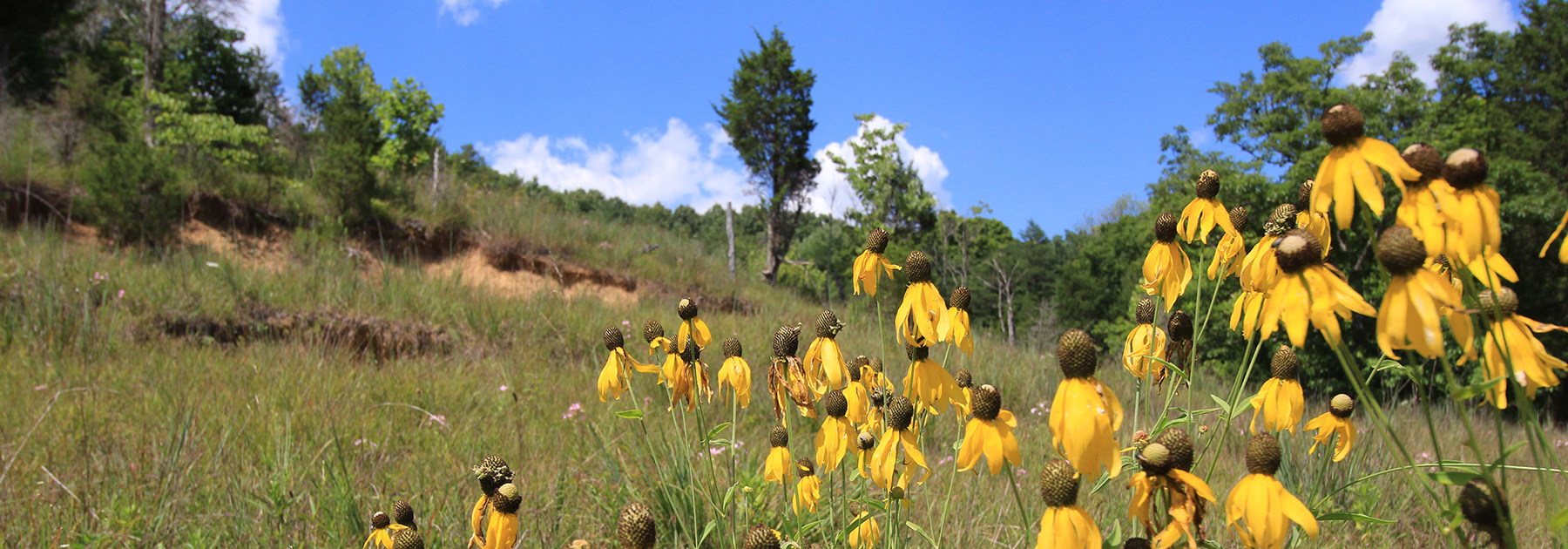
Hiking Trails
The Edge of Appalachia Preserve System has over 9 miles of hiking trails for public use. Three of the trails take visitors through areas designated as National Natural Landmarks and all of the trails give visitors the opportunity to experience the unique and beautiful natural history of Adams County.
Edge of Appalachia Preserve System Rules for Visitation
- Preserve open from dawn to dusk
- Stay on established trails unless granted a written, off-trail permit.
- ATVs, snowmobiles and other motorized vehicles are prohibited
- Pets (except service dogs), horses and bicycles are prohibited
- Trapping, fires and camping prohibited
- Hunting by special permit only
- No littering or dumping
- Alcoholic beverages prohibited
- Firearms are prohibited except when hunting by permit
- The collection of plants or seed, animals, or natural materials or the use of the preserve for scientific research requires written permission from The Nature Conservancy and Cincinnati Museum Center
Joan Jones Portman Trail – 1.6 miles
The Joan Jones Portman Trail winds its way up from the Ohio Brush Creek Valley to Flood’s Point, a relict promontory prairie with sweeping views of the surrounding hills.
Hikers begin by walking through a mix of native grasses and densely growing eastern red cedar trees which gives way to early successional hardwoods such as tulip tree, redbud and sassafras. As the trail continues up the hill, hikers may encounter wildflowers like shooting star, round-leaved ragwort and green dragon. Before meandering in and out of a shale barren, the mix of cedars and small hardwoods create the perfect environment for fuzzy mosses and interesting lichens. As hikers pass through the rocky, grass-filled barren, prairie warblers and other songbirds are likely to be heard. The trail then levels out in an abrupt change in habitat as it has arrived at the first of two Dolostone rock layers. A mix of tall, mature trees form a closed canopy and native spicebush shrubs and pawpaw trees thrive in the understory. The trail switchbacks through the forest and an outcrop of Peebles Dolomite cliffs come into view. Covered in ferns, wild hydrangea and columbine, hikers have the opportunity for an up-close study of this uncommon rock. The trail ends on the top of these cliffs with a view of the valley below. Hikers then retrace their steps to return to the trailhead. The Portman trail allows visitors to get a glimpse of the many different habitats and plants that are found throughout the Edge of Appalachia Preserve.
E. Lucy Braun Lynx Prairie Preserve – 1.4 miles
Unlike any other place in Ohio, The E. Lucy Braun Lynx Prairie Preserve trail is named for the late, preeminent plant ecologist Dr. E. Lucy Braun. Dr. Braun not only studied this area extensively but was instrumental in its conservation, securing the first parcels of this remarkable habitat through the newly formed Ohio Chapter of The Nature Conservancy in 1959. With the transfer of the properties to the Cincinnati Museum of Natural History for management purposes, the Edge of Appalachia Preserve System was born.
This trail system consists of three loops weaving in and out of 10 different dry limestone prairie openings. These unique habitats have received a global conservation status of G2 from NatureServe indicating that they are imperiled worldwide. Each opening is unique and filled with grasses and wildflowers which thrive in the dry, shallow, calcareous soils. Due to the extraordinary plant diversity, the hiker’s experience through Lynx Prairie is a delight in any season, but is best experienced in the spring and mid to late summer. Flowering prairie species include shooting star, hoary puccoon and scarlet paintbrush in the spring followed by various coneflowers, rose pink and several species of blazing star in the summer. Along with Buzzardroost Rock, Lynx Prairie has been designated a National Natural Landmark and is a must-see on the Edge of Appalachia Preserve.
Charles E. Eulett Wilderness Preserve – 2.6 miles
The Charles A. Eulett Wilderness Trail is named after an Adams County teacher and naturalist who shared the importance of nature and conservation with his students and neighbors. Due to the unique and outstanding biological makeup of the area, The Wilderness Preserve was designated as a National Natural Landmark in 1974.
Looping through an ever-changing backdrop of forest, cliffs and streams, the Wilderness Trail has something to offer in any season. Fascinating geology, towering trees, spring wildflowers and migrating songbirds are just a selection of natural history delights hikers can encounter along the trail. Fall and winter are the best times to view the tall, Peebles Dolostone cliffs which are home to rare plants and animals. Plant highlights throughout the trail, depending on the season, include northern white cedar, Carolina buckthorn, pink and yellow lady slippers, American Colombo, scarlet cup and stiff gentian. The spring migration of warblers and other colorful songbirds can be seen and heard from all parts of the trail especially during the first part of May. Close to 200 species of birds have been observed utilizing the Edge of Appalachia. During the latter part of April and into May then again in July and August, Shivener Prairie bursts into a colorful pallet of wildflowers which attracts a myriad of bees, butterflies and other interesting flower visitors. This rocky, rugged trail winds up and down hills giving hikers an up-close look at the diversity of natural history encompassing the Edge of Appalachia Preserve.
Christian and Emma Goetz Buzzardroost Rock Preserve – 4.4 miles
The Christian and Emma Goetz Buzzardroost Rock Trail is one of the Edge of Appalachia Preserve System’s most popular trails—for good reason too. This enjoyable hike leads visitors through prairies and forest, over streams and springs, across ridgetops and culminates in one of the absolute best views in the state of Ohio.
Designated a National Natural Landmark in 1964 along with Lynx Prairie, Buzzardroost trail winds its way along the edge of two different ecoregions. The diversity in geology, plant life and animal life is at its maximum as the Appalachian Plateau region collides with the Interior Low Plateau. The former region sustains acidic soils and the plants that thrive in them, while the latter supports globally rare xeric limestone prairies, dolomitic rock outcrops and mixed mesophytic forests. Enjoyable in any season, hikers can find a variety of spring and summer wildflowers, ferns, geological features and a stunning vista. Situated high above the Ohio Brush Creek Valley, the stunning view from Buzzardroost Rock is a must-see. Especially vibrant during peak fall color, the panorama stretches from the feeder stream in Leisure Valley down to Ohio Brush Creek and continues downstream towards the Ohio River and Kentucky.
Improvements to the hiking trail in 2014 and 2015 included the addition of a loop along the central section of the trail allowing hikers to experience the flora and fauna of a xeric limestone prairie. A visit to Adams County is not complete without a trek on the Buzzardroost Rock Trail and taking in the incredible view from the overlook.
Helen C. Black Trail at Cedar Falls – 3.0 miles
The three-mile, round-trip trail to Cedar Falls begins placidly among a grove of eastern red cedar trees and ends at a dramatic overlook perched on the edge of a cliff above the falls. Along the way, you will experience diverse deciduous forest, cross several rocky tributary streams and pass through the boulder field—a narrow area of Cedar Run gorge where massive blocks of Peebles Dolomite have fallen from nearby cliffs. This hike is strenuous in some areas, and the 70-foot cliffs are impressive but very hazardous without caution. Direct access to the falls is strictly prohibited. For your own safety, you must stay on the trail at all times.


